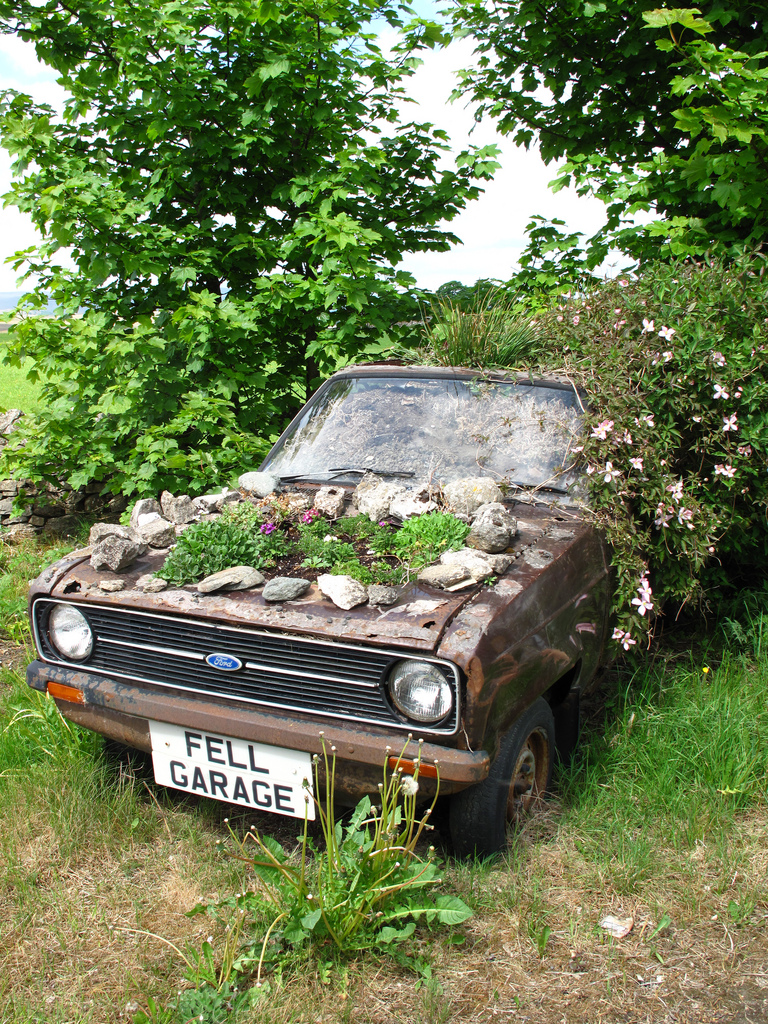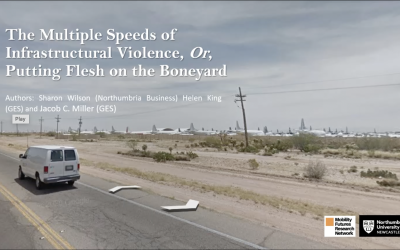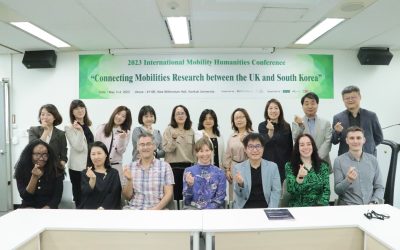‘Are alternative ways of modelling the relationship between past, present and future in order to move historical and/or text-based mobilities research rather more to the centre?’. Professor Lynne Pearce, our guest blogger this week, tries to answer this question.
Although my own disciplinary background is in literary and cultural theory, I have chosen to write about historical mobilities for this blog for the good reason that all text-based research is, of necessity, dealing with historical material – be this literature written in the sixteenth-century or a newspaper article published last week.
While English departments have arguably obscured the implications of this by extending ‘the contemporary’ back as far as the 1960s, sociologists and cultural theorists now recognise ‘the recent past’ as a distinct historical category that begs to be considered in its own right. If we accept, then, that all research that relies upon textual material for its data is historical to a greater or lesser extent, questions immediately arise about how those of working in those fields can make a meaningful contribution to social science-based mobilities research which is typically both grounded in the present and/or future-oriented?
There is one well-worn answer to this question with which everyone reading this blog will be familiar: namely, that we all – individuals, inventors, communities, nations – do, and must, engage with history in order to (a) avoid repeating the mistakes of the past and (b) to ‘learn’ from it more generally. Universally accepted, this is the rationale which ensures that historical research continues to receive (some) government funding even in austere and cash-strapped times, with the AHRC’s recent funding stream ‘Care for the Future: Thinking Forward through the Past‘ being a notable case in point.
I would argue, however, that is important for those of working in, and through, historical and/or text-based materials not to be fooled into thinking that the intellectual respect and ‘support’ for our work exercised through this rationale means that we are on an equal playing field with colleagues whose research speaks to current/future social issues much more obviously, especially when it comes to funding. Across the UK Research Councils, the proportion of funding allocated to Humanities-sourced research is disproportionately small, but the further concern – encapsulated in the AHRC funding stream cited above – is that such a strong steer has now emerged as to how we should conceptualise and package our research.
Is ‘thinking forward through the past’ the only way in which text-based and/or historical research can be understood and justified from a funding perspective?
Although most researchers presumably accept the need for government funding to be accountable, there is surely a danger that certain types of research – in the context of an impact or policy-led agenda – is, by default, now destined to play no more than a minor and/or supporting role. When we consider how literature-based research is, for example, informing work in the Medical Humanities, this can, of course, be seen to be a highly significant supporting role; however, I would suggest that a debate needs to be had about whether ‘thinking forward through the past’ is the only way in which text-based and/or historical research can be understood and justified from a funding perspective? This is a debate, moreover, that is highly topical for those of us working in a mobilities context; for while there has been a long-standing openness to the use of literary and other historical texts in investigating the social and cultural significance of transport and other mobilities, large project funding – with one or two notable exceptions has been focused very firmly on the present.
Needless to say, I have asked these questions in a somewhat simplistic and unqualified way in order to open up the debate, but end with a scenario – based on my personal research interests – that might help ‘historical’ researchers think through the restrictions now placed upon our research (in funding terms, at least) and what it would take to shift the conceptual parameters within which we work.
Since the millennium (and, indeed, long before if you take into account the fact that I was born into a garage-owning family), I have been interested in the ways in which driving impacts upon how we see, think and feel. Most recently, I have completed a book – Drivetime: Literary Excursions in Automotive Consciousness – which draws upon literary texts from across the twentieth-century in order to explore, in particular, driver cognition: literally, ‘what we’re thinking when we’re driving’. Given that perception/cognition has long been a concern of scientifically-based automobilities scholarship, it would probably not be difficult to discover ways in which I could now ‘apply’ the findings of this project to research being undertaken in other disciplines: for example, my textual analyses support debates on how the changes in cognitive behaviour consequent upon the introduction of ‘driverless cars’ will impact profoundly on driver/passenger experience (Laurier and Dant, 2011); and they also speak to the ethnographic studies being undertaken by automotive psychologists on driving and daydreaming (He, J., E. Becic, Y.C. Lee and J.S. McCarley 2011).
The garages that line the A6 north of Lancaster, for example, are falling away on a yearly basis, and within another decade – twenty years at most? – will almost certainly be gone for good.
However, there is another – quite different – automotive research project that I should also love to undertake that, on the face of it, is unlikely ever to secure funding on account of the fact that its ‘care for the future’ is not easily discerned; indeed, it might even be considered a retrogressive retreat from the only future now available to us in automotive terms. This fantasy project – which travels with me every time I drive from Lancaster to Scotland (as I regularly do) – would be an multi-disciplinary archaeological ‘recovery’ of one of the main road routes north – such the A6 – in order to capture the fast-disappearing infrastructure of the twentieth-century motoring before it completely disappears. The garages that line the A6 north of Lancaster, for example, are falling away on a yearly basis, and within another decade – twenty years at most? – will almost certainly be gone for good. In terms of the global ecological imperative to move beyond the car, one response is, of course, ‘good riddance’. And yet there are evidently hundreds like me who share a fascination with this particular vestige of our fast-fleeing ‘mobile’ past; possibly because what is/was so pervasive is now vanishing so quickly. Admittedly, this is a disappearance that has to be set alongside the fact that car itself has, as yet, shown no sign of giving up the ghost (Dennis and Urry, 2009), but it is hard not to respond to this changing roadscape as, at very least, a presage of things to come.
Meanwhile, the many thousands of enthusiasts that share my interest in this vanishing motoring landscape are typically not academics but rather amateur historians and/or the general public who share a passion for both recapturing the past and marking its passing. This twin objective is demonstrated by Chris ‘Wolfie’ Smith’s amazing study of ‘The Great North Road’ (now incorporating large sections of the A1), The Great North Road – Then and Now (2013). An independent truck-driver, Smith has used his life-time of travel up and down this same stretch of road both to chart its gradual (and sometimes not so gradual) transformation and to construct a ‘then and now’ portrait of the length of the route using historical and contemporary photographs. Likewise, there are several websites – run by enthusiasts – seeking to capture the history of the British road system, including the A6, thus demonstrating that my own fascination is neither singular nor academic.
What I am fantasising here is an ambitious cross-disciplinary venture that would bring together historians, archaeologists, ethnographers and ‘textual’ critics like myself interested in the literature(s) of the road.
My immediate question here, then, is how one might conceptualise a historical mobilities project of this kind in such a way that it is fundable – particularly in the current UK funding climate where ‘heritage’ (the buzz-word of the 1990s) has largely dropped off the agenda? It could be that there will be colleagues out there who read this blog and come back to me saying that they have been lucky enough to get funding for similar projects – and, to be clear, what I am fantasising here is an ambitious cross-disciplinary venture that would bring together historians, archaeologists, ethnographers and ‘textual’ critics like myself interested in the literature(s) of the road –, in which case a very useful conversation might be had about how such projects were framed and legitimated. However, even assuming (as I am) that this is not the case, the same discussion should arguably be had. In particular, we surely need to explore whether there is any way of conceptualising such projects other than their relevance to our notional ‘care of the future’? For, if we are forever bound to this single axiom, it is my fear the ‘pathways to impact’ rationale for all historically-sourced projects will soon appear tired and exhausted. Our object(s) of study may change, but our ‘promises’ will remain the same and become less and less convincing; for, as all of already know, impact is so much easier to promise than deliver.
Returning, finally, to my own fantasy project, it is clear that contemporary social and cultural significance could be built into it, not least by making the fascination of myself and other ‘amateur historians’ part of the research: in other words, it could become a project about our nostalgia for, and reluctance to transition from, the recent past. However, I also know that what compels me, ‘Wolfie’ Smith and the members of Trucknet.UK to keep returning to these traces of our recent automotive past – textual or otherwise – is a desire to immerse ourselves in it as holistically as possible, and with the naïve pleasure of understanding it ‘for its own sake’. The question I am asking here, therefore, is whether there are other ways of formulating the significance of historical and/or text based research other than its – often tenuous – claim to its potential benefit for ‘futures’ thinking? Or, assuming that this is the rationale we must live with, whether there are alternative ways of modelling the relationship between past, present and future in order to move historical and/or text-based mobilities research rather more to the centre.
Bibliography:
Laurier, E., & Dant, T. (2012). ‘What else we do while driving: towards the driverless car’. In M. Grieco, & J. Urry (Eds.), Mobilities: New Perspectives on Transport and Society. (pp. 223-244). (Transport and Society). Ashgate Publishing Ltd.
He, J., Becic, E., Lee, Y.C., McCarley, J.S. (2011) ‘Mind wandering behind the wheel: performance and oculomotor correlates‘,
Hum Factors, 53(1):13-21.
Dennis, K. and Urry, J. (2009) After the Car, Cambridge: Polity.
Professor Lynne Pearce
Department of English & Creative Writing
CeMoRe Director for the Humanities
Main photo: Fell Garage, in Shap, Cumbria, one the garages that line the A6 north of Lancaster. Foto: Colin Wells / Flickr.




